With Federal Help, A Big Project Reset Shows the Way at NYCHA
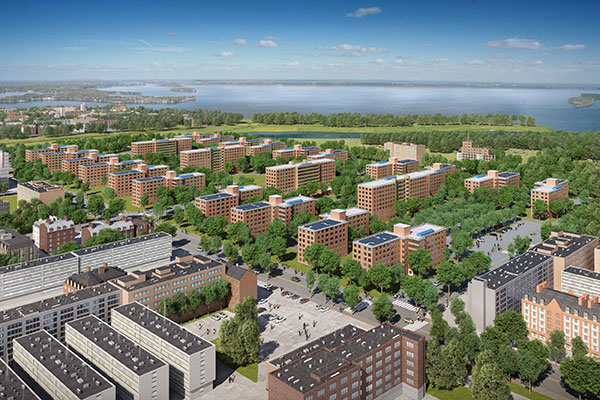
This is the second in a two-part series on transformations and experiments happening at NYCHA. Read part one: At NYCHA, A Small Project-High Concept Reset.
The conversion of the Ocean Bay (Bayside) project, housing 4,000 Rockaways residents, to private management through the federal Housing and Urban Development’s Residence Assistance Demonstration (RAD) program is far advanced. Ocean Bay flooded badly during Superstorm Sandy and has been on temporary boilers since the floods. While the damage was most severe to the mechanical systems rather than apartments, lobbies, elevators, or interior hallways, post-Sandy the complex continued to decline with problems of trash, leaking ceilings, and more.
Ocean Bay is also isolated: close to the beach and other housing projects but not much else. There isn’t a decent grocery store, or much of any stores or community services, within walking distance. But there are assets, if you know where to look.
The first major asset is the 1,395 apartments in 24 towers, nearly all still occupied by now former NYCHA families. Livable apartments in hot-market New York City are attractive opportunities, particularly if they are, as is the case here, delivered without an underlying mortgage. To simply develop the equivalent number of housing units might costs as much as $750 million (1,400 units at $400,000 each), take years of permits, incur many delays, etc.
Similar dilapidated public housing units would be less valuable in other cities, and many towers of similar scale and style have been destroyed across the country, but New York is different because of the demand for all housing, public or private.
The second major asset is the multiple set of government subsidies available to the developer. RDC Development, a joint venture between MDG Design + Construction and Wavecrest Management Team, has borrowed money in private markets that might not be available in less desirable housing markets. Most of the $560 million in renovation funding, including private loans, is also secured by the government including a future role for Section 8 (for operating support), FEMA (resiliency for future storms), federal Low Income Housing Tax Credits (attracting private-sector lending), New York State’s Housing Finance Agency (state-secured financing), and NYSERDA (energy conservation).
When you put all the layered subsidies on top of mortgage free units, you start to understand private-sector interest in these conversions. The developer expects to collect developer fees and some construction profits; the management company, Wavecrest, will also be able to collect management fees in the long term if all goes well.
It would be wrong, however, to view this conversion as easy money. The developer is taking a major risk on the current tenants as the future rent returns plus government subsidies will have to be sufficient to operate the buildings, maintain them, pay management fees, and cover the debt service. The developer/management will also have to keep NYCHA management happy in the long term, including using NYCHA waiting lists for future tenants, despite whatever shifting political winds may come along. And no one knows what will happen to federal housing subsidy programs in the coming years.
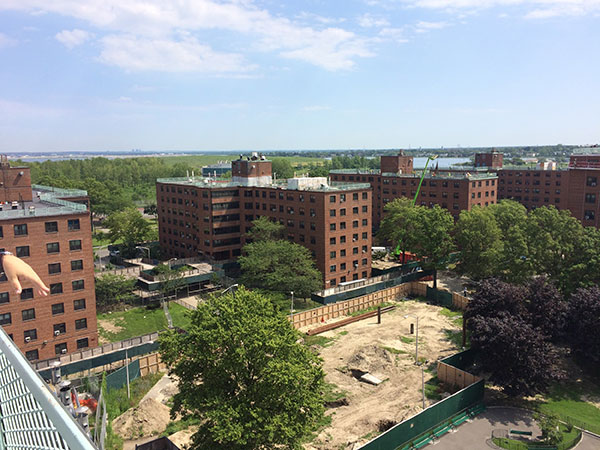
Redesigning What Matters First
The layout of the complex is moderately attractive by NYCHA standards. The four central towers are just nine stories tall each, so most of the apartments at Ocean Bay are located in the 20 six-story buildings flanking the central high rises. The grounds, despite having flooded, boast mature London Plane trees. The complex was moderately updated during the Hope VI process two decades ago including some cosmetic improvements to the grounds, elevator lobbies, and apartments.
The apartments are decent size by NYCHA standards and quite a few are very large (five bedrooms). The developer has a solid eye to what matters for resident satisfaction. Some of the original apartments were in very poor shape, with severe water damage, but most apartments have required upgrades and moderate renovation rather than gutting. The developer is thus switching out cabinets, laying down new vinyl strip floors, updating bathrooms, patching ceilings, and so forth. Current apartment configurations will remain as is. The apartments turn out respectable as a result of these modernizations; costs and complexity remain within the parameters of a renovation project.
 |
 |
Big-ticket, long-term quality of life repairs are the focus of building-wide renovation. The developer is adding a more reliable and efficient heating system (on the roof to avoid future floods), new roofs, new windows, lintel brick repointing, lobby renovations, solar panels, and a protective berm and water retention swales. The developer is deferring cosmetic exterior additions and extensive landscape plans, which are still planned, until the site has been stabilized and any unexpected problems are addressed.
Delivering quality basics today means steam-cleaning and shining up existing floors and glazed brick halls inherited from NYCHA, widening the trash chutes that often overflowed, and running an expensive, and more efficient, heating system along those hallways. It means new windows that are similar in look to the old ones, but open more easily to help aid air circulation. It means new cabinets that provide an immediate sense of improvement. It means a protective berm for future floods and resilient electrical system. It is these investments that will distinguish the project in terms of livability from other postwar NYCHA projects in the years to come.
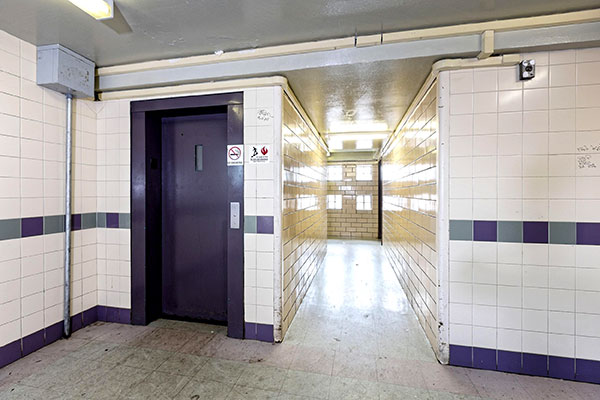
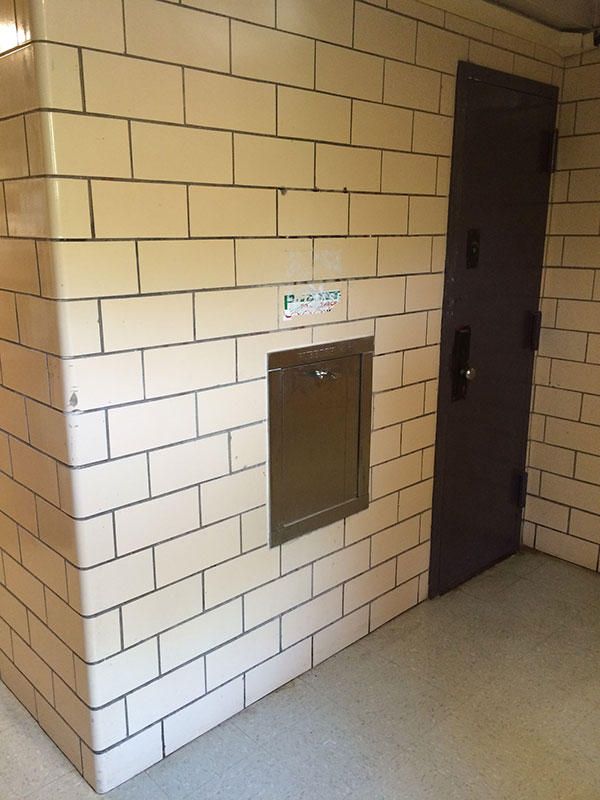 |
 |
The private management has also dispensed with NYCHA’s expensive labor system. This change has financial implications (lower operating costs) in the long term. Wavecrest, an experienced property management company, is now in charge of the entire complex—from rent collection to general maintenance. NYCHA employees opted to be moved to other NYCHA properties rather than transition to Wavecrest which would have meant more modest benefits, looser work rules (under a new union), and higher expectations.
The aim of the renovation and new management is to reset the tenant-management relationship and collect rent more consistently than NYCHA by being a better property manager. Wavecrest’s management fees, and the financial security of the property, is dependent upon steady rent collection. If Wavecrest can maintain higher standards in the long term, the project can enter a new era of stability. So far, says the developer, the rental collection under private management has been meeting expectations. It should be noted that the developer cannot, like Mitchell Lama conversions, rent empty apartments at market rents. This project thus retains its deep affordability for the foreseeable future.
Families accustomed to NYCHA’s de facto tolerance for late or no payment, and significant amounts of problematic behavior in courtyards and hallways, will need to adjust to private sector standards. The signs are encouraging that the new environment is already improving the quality of life. The developer reports reductions in the level of graffiti and other costly damage.
The developer is not, however, relying on resident satisfaction alone. Ocean Bay is massive, at 33 acres, with many entrances, stairwells, hallways, etc. It is also isolated and the neighborhood retains an air of disinvestment. The developer, per consultant advice, plans to install an electronic fob system for entry and movement through lobbies and other building private spaces, typical of market-rate buildings. In addition, 400 cameras will be installed across the site. These will be actively monitored by a private security company out-of-state. Security staff observing project activities will not only be able to report problems to the police, but will be able to speak directly to people caught on camera through a broadcast system. The aim of this “voice of god” is to help tenants feel the management presence -- in a good way, we hope.
There are plenty of additional opportunities for upgrades. NYCHA and the developer decided to delay but not rule out infill development of large open spaces within the project. Ocean Bay could benefit from additional housing or commercial operations that would enliven the area. Additional affordable housing units would also be welcome. In Europe, for instance, large and isolated public housing projects have been infilled with a mix of subsidized, market, and retail buildings to reduce the isolation and create more lively communities. Yet Ocean Bay has so many upfront issues that stabilizing the project as a living space came first. Infill is also politically controversial and can be a distraction. Without any additions, Ocean Bay already offers tenants a higher standard of living, but will also remain both geographically and socially isolated for the time being. The beach is, however, just a few blocks away.
This is the second in a two-part series on transformations and experiments happening at NYCHA. Read part one: At NYCHA, A Small Project-High Concept Reset.
***
Nicholas Dagen Bloom is an Associate Professor at NYIT and author of “Public Housing That Worked.” Matthias Altwicker, AIA, is an associate professor of architecture at NYIT and principal and founder of Studio A+H.
***
Have an op-ed idea or submission for Gotham Gazette? Email This email address is being protected from spambots. You need JavaScript enabled to view it.
The MTA’s Long-Term Financial Problem Is Severe and May Soon Be Worse
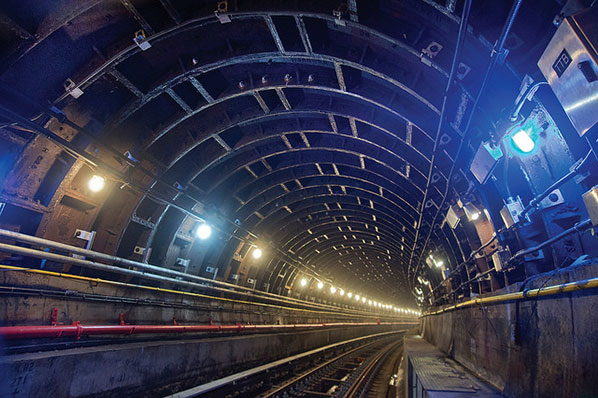
(photo via MTA)
Summer 2017 saw a political breakthrough for mass transit riders when Governor Cuomo declared a “Transit Emergency“ after the Harlem subway derailment, effectively acknowledging the State’s responsibility for addressing the deteriorating and delay-plagued subway, bus, and commuter rail system.
Within a month, the MTA’s new Chair, Joe Llota, proposed an $836 million “Subway Action Plan” to address the emergency, meaning major upgrades to the MTA’s maintenance operations and other investments to attack the constant delays and bring some meaningful relief to riders. He proposed the MTA and the State split the cost of the new program with the City, which drew a near immediate rebuff from Mayor de Blasio.
The MTA began implementing the plan, deploying late-night work crews on system segments to clean debris and fix track and signals, without a clear answer to where it will get the money. The Subway Action Plan became part of the MTA’s constant dilemma - where can it pull together resources for both its short-term and its long-term needs, which are far larger than the $836 million action plan. Seemingly aware of this, the emergency declaration and the subway action plan response precipitated another move by Governor Cuomo.
In mid-August Cuomo endorsed “congestion pricing,“ claiming it was “an idea whose time has come.” Congestion pricing puts a toll on the free East River Bridges into Manhattan, as well as a toll for vehicles crossing 60th street toward the city’s business district.
The money from the tolls would provide the cash to repay money the MTA generally borrows for its capital needs. Those needs include buying new subway cars and buses, replacing track and signals, rebuilding stations, elevators, escalators, and railyards, continuing expansion projects like the Second Avenue Subway and East Side Access, and installing computer-based train control, which could increase the number of subway trains running during the crowded rush hours.
Move New York, an advocacy group, has a detailed plan, which includes vehicles paying one round-trip at the same rate as the Battery and Midtown Tunnels ($5.76 with E-Z Pass, $8 without), and lowering tolls on many of the non-Manhattan destination bridges in the rest of the boroughs
The governor does not yet have his own specific plan, and imposing these tolls must have approval of the State Legislature, which is not in session and will not return to Albany until January. This means Cuomo will likely submit a congestion pricing plan with the budget in January, in the hope it would be approved by April 1, 2018. Mayor Michael Bloomberg made a congestion pricing proposal in 2007 and 2008, but the Legislature would not approve it, although it consumed a year’s worth of debate. It never even came to a vote.
Meanwhile, Mayor de Blasio said he opposes congestion pricing because it is “regressive,“ by which he means that it is a tax on ordinary working people, not the rich.
I served in the New York State Assembly for 32 years, and in 2007 I was Chair of the Assembly Cities Committee, which dealt with the internal workings of the state’s 62 city governments. I had regular dealings with the Bloomberg administration and endorsed congestion pricing. Most of the debate, however, was not about funding the MTA, but about whether the tolls would really deter cars from driving into Manhattan, and whether the neighborhoods in Brooklyn and Queens near the bridges would fill up with cars parked by drivers looking to avoid the tolls and then taking the subways into Manhattan for the last leg of their trip. Of course, unfairness to people of modest means was another major concern. My point of view was that the MTA Capital Plan needed a major new source of funding but that perspective was less of a priority then than it is today.
Several years later I became Chair of the Assembly Committee on Corporations, Authorities, and Commissions, which has jurisdiction over laws affecting the MTA. I also helped lead the Assembly’s negotiations with the governor and the Senate over the mass transit aspects of the transportation budget. By 2014 the MTA’s 2015-19 Capital Plan had become the subject of extensive discussion, and the MTA had a $15 billion shortfall in funding for the $32 billion plan that was in the works.
Move New York had made its new congestion pricing proposals by then, which I supported. Concerned that congestion pricing might never be approved by the Legislature, I also introduced about six bills intended to help meet the MTA shortfall. Some of the bills addressed road and bridge funding as well. But the governor’s office argued that providing specific additional funds to the MTA would not work because it could not spend more money (which the MTA leadership did not agree with but would not disagree publicly with Cuomo).
Governor Cuomo vetoed the initial MTA Capital Plan proposal in October 2014, which ended up forcing the MTA to cut the plan from $32 billion to $29.5 billion. In the 2016 budget, the Legislature approved the governor’s plan to commit the State to $7 billion in new funding for the Capital Plan, while New York City would supplement the funding with $2.5 billion of its own.
With those commitments in place, the MTA proceeded with its approved plan. The problem then, as now, is that the $7 billion from the State was just an IOU. There was no identified source of funding for the $7 billion, only a commitment in law that the State would provide the funds after the MTA ran out of its own resources.
In late 2019 the MTA will have to submit a proposal to the Capital Program Review Board for the 2020-2024 plan, which is expected to be similar to the past several plans, needing $30 billion for full funding. In the current plan, the MTA had identified about one quarter of the funding from the federal government and about one third of the funding from its own resources, meaning either cash upfront or enough cash to cover the interest on borrowed funds, before the state government settled on the 2016 plan that passed.
For 2020-24 it is not known how much more cash the MTA can squeeze from its current resources. The MTA Financial Plan adopted by the Board in July showed rising deficits because revenue from real estate taxes is in decline, meaning its ability to generate more cash resources internally will be very limited. A reasonable person could foresee a shortfall for the 2020-24 plan similar to the one that affected early planning for the current capital plan, namely $15 billion. When you combine that with the unidentified resources for the State share of the current plan, some $7 billion, the total ‘shortfall’ going into 2020 would be $22 billion. Does this suggest the MTA needs a new source of revenue?
More than $20 billion in need going into the 2020-24 capital plan is catastrophic. Not all the cash is needed right away, of course, but the governor and the Legislature, I think, should probably do something meaningful pretty soon.
***
Jim Brennan was a member of the New York State Assembly for 32 years, where he chaired four committees. On Twitter @JimBrennanNY.
***
Have an op-ed idea or submission for Gotham Gazette? Email This email address is being protected from spambots. You need JavaScript enabled to view it.
At NYCHA, A Small Project-High Concept Reset

Why on earth would private companies be interested in renovating and running public housing in New York? From the headlines about conditions and crime, and deferred maintenance in the billions, it is hard to imagine why private interests would want to touch a NYCHA housing project. Yet the conversion to private management is well underway and NYCHA has proposed the conversion of thousands of additional units to Section 8/private management. Two articles consider strategies underway for both small and large projects visited during 2016-2017. The following is the first of the two, with the second to be published on Friday, September 29.
In the heart of the Bronx’s Melrose district, known for its successful program of affordable housing, an experiment crucial to the future of New York City is underway. The New York City Housing Authority (NYCHA), private developers, and designers have remodeled a public housing tower block, Bronxchester Houses, for another generation of deeply subsidized living. By embracing high-rises, rather than demolishing towers, the city is swimming against the national tide of public housing destruction. With so many New York City residents in NYCHA housing developments (at least 400,000 people), and so much of that high-rise housing decaying, the outcome of the experiment matters more than ever.
Bronxchester Houses in the South Bronx, with 208 apartments, is representative of the design strategy for six small sites, with 875 apartments total, recently transitioned into a public-private partnership. At Campos I, another of the six, a similar strategy is in the process of implementation.
Bronxchester, Campos I, and the other sites had been managed by NYCHA for decades, even though they were always Section 8 funded projects that normally would have been managed by the private sector. Following a 2013 request for proposals, NYCHA entered into a long-term agreement with Triborough Partners, the development team of L&M Development Partners (a well-known affordable housing developer and manager in the city) with Preservation Development Partners, that put the private developers in charge of rehabilitating and maintaining buildings on the six NYCHA sites in Manhattan, Brooklyn, and the Bronx. The renovation was financed through a combination of public and private financing including tax-exempt city bonds.
Armed with a relatively robust budget for a small project, and freed from many NYCHA and federal public housing guidelines and rules, the development team and the designers rethought the Bronxchester project from the ground up.
The architecture and branding firm GDS led a design intervention big enough that Bronxchester now looks more like private affordable or even market-rate housing than it does a typical NYCHA tower. GDS designed giant gray frames, made of Ecotone-panels, that were applied around the edges of the buildings’ façades. Intended to bring down the scale of buildings, the frames stop two floors above ground level, with bases of the buildings painted gray. The renovation also provided larger windows for ground-floor community spaces.
GDS principal Michael Kirschmann told us that while “people dismiss affordable housing as not cool...there are a lot of opportunities to be thoughtful.” Indeed, the Bronxchester building looks different, and better, both close-up and far away. The building’s new contemporary look complements its neighbor, the well-known below-market housing development Via Verde, designed by Dattner Architects and Grimshaw Architects and built in 2012. Bronxchester’s exterior renovations, it should be noted, are subject to much more strict fire codes than London had in place before the tragic Grenfell fire.
At Bronxchester, the rebranding strategy continues inside. OCV, the architect of record for the projects, designed straightforward interior renovations that aim to generate a pride of place and “market” feeling for buildings typically outfitted with standard-issue NYCHA furnishings, long in need of repair. New kitchens and bathrooms, along with integrated heating-cooling window units, were installed in all apartments. New flooring, paint, tile, and lighting brightened up hallways.
|
|
|
The tenants are also benefitting from bright, ground floor laundry rooms, glass-enclosed lobbies, and spruced up community spaces for meetings and parties. New elevators and roofs were installed to address essential quality of life issues.
|
|
|
The strategies make the most of good looking off-the-shelf products (light fixtures, vinyl tile, ceramic tile) typical in hotels and market apartment buildings that NYCHA has usually avoided because of their lack of durability. The private managers simply intend to replace these elements as they are damaged, factoring these replacement costs into operating expenses. The strategy opens up a much wider range of possible design solutions.
The most striking aspect of the renovation is the transformed courtyard. Landscape architect Joanna Pertz wanted the site’s open spaces to feel “safe but free.” Her first instinct at Bronxchester was to make the site as open as possible to the adjacent neighborhood. After residents told her they wanted a defined semi-private space, she created a final design that “hardens the edge, and opens up the center.”
Her landscapes, most of which are for residents and their guests only, are designed with zones for different age groups. She imagines, for instance, preteens sitting and drawing on the amphitheater steps, teenagers playing basketball at the new full-sized court, and seniors watching the action from afar, in an area protected by trees. Where there was once 7,000 square feet of play space at Bronxchester, there is now a 24,000 square foot courtyard.
|
|
|
|
Many of the architectural decisions address security rather than looks. At Bronxchester, for instance, management gated the interior spaces described above, which were previously open to the street, and increased exterior lighting, particularly at entry and gathering spaces. Tenants now use key fobs to access the buildings and private outdoor areas. Increased funding for operations allows private security staff to be on site at the entrance for nearly all hours of the day, including most of the night. Cameras also keep an eye on interior and exterior spaces. Gating reduced community access, but the enhanced tenants’ sense of safety and new renovations make the ground plan more intensively used by residents and their guests.
|
|
|
Tenant leaders have seen a difference since security was increased. Patricia Lamonda, Tenant Association President at Bronxchester Houses, said, “Seniors are sitting outside and getting fresh air. Now that we have security, tenants don’t have to watch drug dealers coming into their building and trying to sell. The problem is the people who are not on the leases.”
There is still some ground-level space accessible to the general public, but it is better designed than before. Neighbors and residents now mingle in the unsecured areas in front of the building. These public areas, in fact, were also redesigned with better seating, lighting, and landscaping. They are also observable from security, making them more attractive to most tenants. Bronxchester, and other sites like Campos Plaza I, have also benefitted from surrounding neighborhood investments, both public and private, that have contributed to public safety and neighborhood livability.

Bronxchester is now managed by C+C Apartment Management, L+M Development Partner’s management subsidiary, which has increased on-site maintenance and management staff at all sites. The small NYCHA staff that was on site before the renovations was relocated to other sites. New, responsive management contrasts with what tenant leaders characterize as NYCHA’s “band-aid approach.”
With C+C now in charge of operations, tenant leaders describe living with the same regulations as they did under NYCHA, but with greater enforcement. While manager and tenants alike feel the new management has improved tenants’ lives, C+C has also helped to restore tenant faith so that rent can be regularly collected.
Triborough and C+C must still comply with applicable Section 8 and LIHTC rental management regulations under the terms of their 25-year contract. Tenant rents, as a result, have not increased and will remain at their current (low) levels. L+M also gave payment plans to tenants who owed back rent payments. In interviews, the private managers made clear that rent collection is a priority.
While the improvements at Bronxchester are encouraging, the long-term impacts of the public-private agreement are unknown for resident families, especially given the current federal administration. The same type of vigilance housing advocates apply to NYCHA will probably need to be applied to the private managers in the long term.
Early successes at renovated NYCHA sites like Bronxchester come not from one strategy, but from a combination of architectural upgrades, improved management, and expanded security, all made possible by the increased subsidies opened up through the Triborough public-private agreement.
The tenants we spoke with were all thrilled finally to have well-maintained apartments and common spaces, responsive management, and safe, well-designed outdoor spaces, all without having their rents increased. Bronxchester shows what is possible with increased investment for housing rehabs and room for design experimentation. It also gives the chance to evaluate existing regulations. With NYCHA’s 334 developments, holding 2,602 buildings, many of them in disrepair, hundreds of thousands of residents across NYCHA properties could benefit from improved conditions and better designs, as Bronxchester residents have.
Read part two of this series: With Federal Help, A Big Project Reset Shows the Way at NYCHA
***
Nicholas Dagen Bloom is an associate professor at the New York Institute of Technology and author of "Public Housing That Worked." Karen Kubey is an Architectural and Housing Consultant at karenkubey.net.
***
Have an op-ed idea or submission for Gotham Gazette? Email This email address is being protected from spambots. You need JavaScript enabled to view it.













